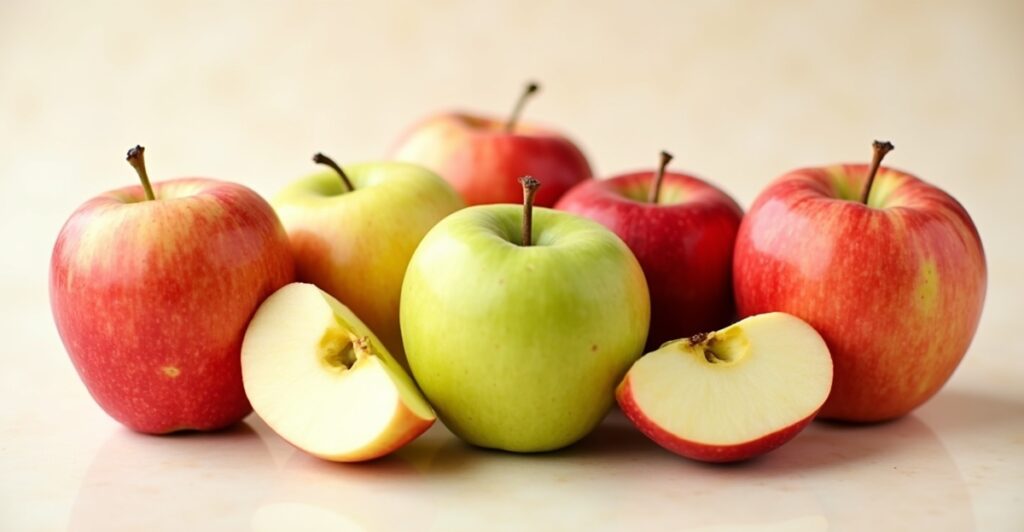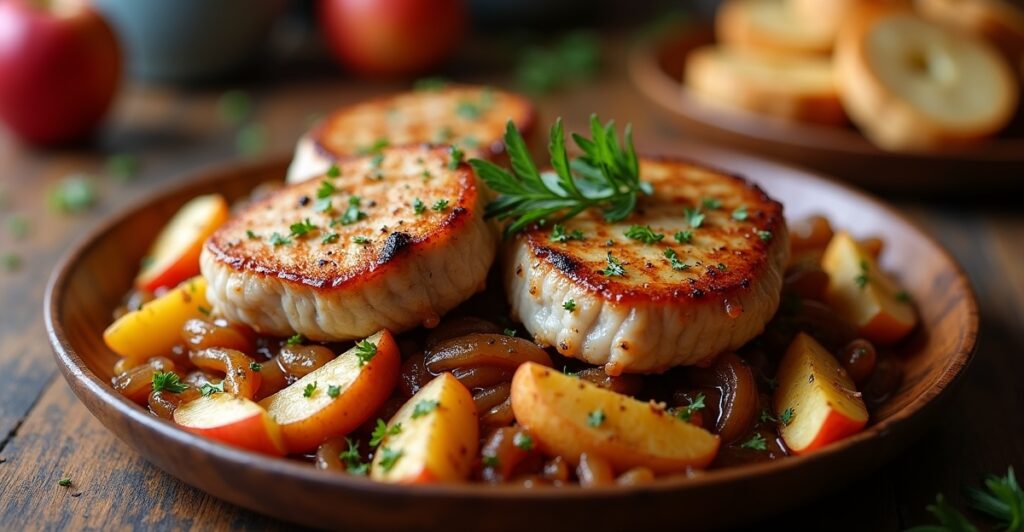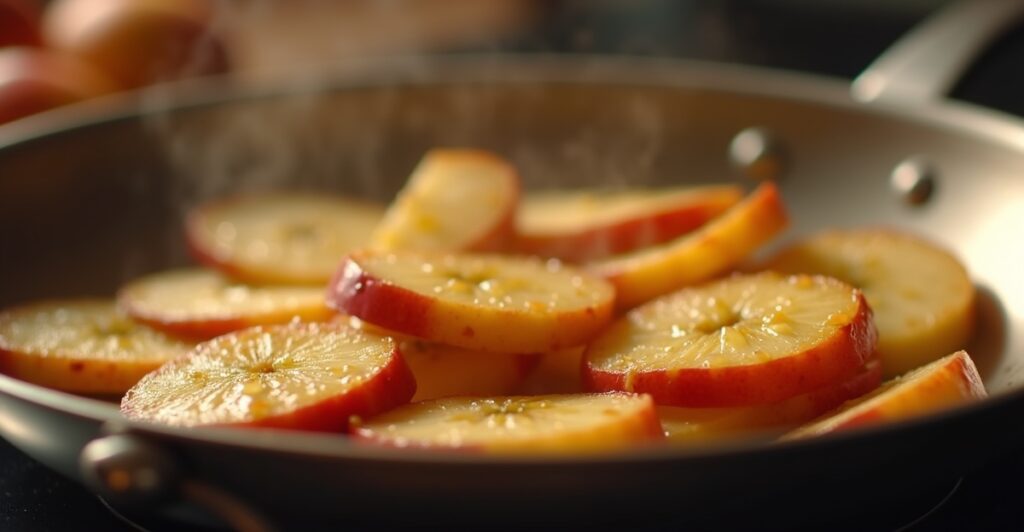Apples: The Unexpected Savory Star
When most people think of apples, their minds immediately drift to sweet pies, crisp tarts, or warm cinnamon-spiced desserts. But here’s where we flip the script entirely: apples are culinary chameleons that shine just as brilliantly in savory applications. From cutting through rich pork belly to adding refreshing crunch to autumn salads, these versatile fruits bring complexity and balance to dishes you’d never expect.
What are Savory Apple Recipes?
Savory apple recipes ingeniously incorporate the unique sweetness, tartness, and texture of apples into non-dessert dishes. Apples balance rich meats, cut through fats, and add refreshing crispness to salads and side dishes, creating complex and delightful flavor profiles.
This chef’s handbook will transform how you think about savory apple recipes. We’ll explore why certain apple varieties excel in different cooking methods, uncover surprising flavor pairings that work like magic, and equip you with professional techniques to elevate your home cooking. Whether you’re a beginner seeking simple ideas or an experienced cook craving creative inspiration, prepare to discover apple’s savory potential.
The beauty of cooking with apples lies in their natural ability to bridge sweet and savory elements. Their inherent acidity brightens heavy dishes, while their natural sugars caramelize beautifully when roasted or sautéed, creating depth and complexity that transforms ordinary meals into memorable experiences.
The Savory Apple Palette: Choosing the Right Apple
Not all apples are created equal, especially when it comes to savory cooking. Understanding which varieties hold their shape, complement different flavors, and respond well to various cooking methods is the difference between good and exceptional results. Think of apple selection as choosing the right wine for a dish – each variety brings its own personality to the table.

Top Apples for Savory Dishes: A Culinary Breakdown
Best Apples for Savory Cooking
Apple Variety Key Flavor Notes Texture When Cooked Ideal Savory Uses Honeycrisp Sweet, Mildly Tart Exceptionally Crisp Roasts, Stuffings, Salads Granny Smith Very Tart, Crisp Holds Shape Well Pork Dishes, Chutneys, Baked Apples Fuji Sweet, Juicy Firm Sautéing with Onions, Glazes Gala Mild, Sweet Softens, holds shape Chicken dishes, Mild Sauces
Honeycrisp apples are the workhorses of savory cooking. Their exceptional crispness persists even after cooking, making them perfect for dishes where you want to maintain textural contrast. Their balanced sweetness pairs beautifully with sharp cheeses and herbs like sage or rosemary.
Granny Smith apples are your go-to for dishes requiring apples that won’t fall apart. Their high acidity cuts through rich, fatty meats like pork shoulder or duck, while their tartness balances sweet elements in chutneys and glazes. They’re particularly excellent in long-braised dishes.
Fuji and Gala varieties offer milder profiles that work exceptionally well in delicate preparations. Fuji’s natural juiciness makes it ideal for quick sautés, while Gala’s gentle sweetness complements poultry without overpowering subtle seasonings.
Flavor & Texture: What Savory Cooks Need to Know
The key to successful savory apple cooking lies in understanding pectin content and acidity levels. Apples with higher pectin content, like Granny Smiths, maintain their structure longer during cooking, making them ideal for slow-cooked dishes. Meanwhile, lower-acid varieties like Red Delicious tend to break down quickly, making them better suited for sauces and purees.
Consider the apple’s natural sugar content when planning your dish. Sweeter varieties like Honeycrisp will caramelize more readily, developing complex flavors when roasted or grilled. This caramelization process creates depth that enhances everything from roasted vegetables to grilled meats.
For those wanting to delve deeper into choosing the right apple varieties, understanding these fundamentals will revolutionize your cooking approach. The right apple variety can make the difference between a good dish and an unforgettable one.
Harmonious Pairings: Apples Meet Their Savory Soulmates
The magic of savory apple cooking lies in understanding flavor harmony. Apples don’t just add sweetness – they bring acidity, texture, and complexity that can transform ordinary ingredients into extraordinary dishes. The key is recognizing which combinations create balance rather than competition.
Apples & Meats: The Classic Connection
The apple-meat partnership is perhaps the most intuitive savory pairing, and for good reason. Apples‘ natural acidity cuts through rich, fatty meats while their sweetness balances savory seasonings. Pork and apple represents the gold standard of this combination – the fruit’s tartness perfectly complements pork’s richness while adding moisture to leaner cuts.
Chicken and apple creates lighter, more delicate flavor profiles. The fruit’s subtle sweetness enhances chicken’s mild flavor without overwhelming it. Try sautéing apple slices with chicken thighs, adding fresh thyme and a splash of white wine for an elegant weeknight dinner.
Duck and goose benefit enormously from apple pairings. The fruit’s acidity helps cut through these birds‘ natural fattiness, while roasted apples provide textural contrast to crispy skin. For those interested in mastering the classic pork and apple pairing, the principles remain consistent across different proteins.
Apples & Cheeses: A Marriage of Flavors
Sharp, aged cheeses like Vermont cheddar or aged Gruyère create beautiful tension with apple sweetness. The contrast between creamy, salty cheese and crisp, tart apple awakens the palate in ways that neither ingredient achieves alone. Blue cheeses, with their pungent intensity, find perfect balance with mild apple varieties like Gala or Fuji.
Soft cheeses such as brie or camembert melt beautifully when baked with apple slices, creating luxurious appetizers or side dishes. The key is matching cheese intensity with apple character – stronger cheeses can handle tarter apples, while delicate cheeses pair better with sweeter varieties.
Apples & Vegetables: Adding Sweetness and Crunch
Root vegetables like carrots, parsnips, and sweet potatoes develop enhanced caramelization when roasted alongside apples. The fruit’s natural sugars contribute to browning while adding complexity to earthier flavors. Brussels sprouts and cabbage benefit from apple’s sweetness, which balances their sometimes bitter notes.
Onions and apples create one of the most versatile savory combinations. When sautéed together, they develop deep, complex flavors that complement everything from sausages to roasted chicken. The natural sugars in both ingredients caramelize beautifully, creating a jammy texture that works as both a side dish and a condiment.
For those seeking innovative apple salads, consider pairing crisp apple slices with bitter greens like arugula or endive. The contrast creates dynamic salads that refresh the palate while providing satisfying crunch.
Herbs, Spices, and Aromatics: The Finishing Touches
Sage and apple form one of cooking’s most elegant partnerships. Sage’s earthy, slightly bitter notes provide perfect counterpoint to apple sweetness, making this combination ideal for pork dishes and autumn sides. Thyme and apple offers more subtle harmony, with thyme’s lemony undertones enhancing apple’s natural brightness.
Warming spices like cinnamon, nutmeg, and allspice work beautifully in savory apple applications, adding depth without overwhelming the fruit’s character. Fresh ginger provides bright heat that complements apple’s sweetness, while black pepper adds gentle spice that enhances rather than competes.
Savory Apple Recipe Showcase
Ready to put theory into practice? These carefully curated recipe categories demonstrate apple’s incredible versatility across different courses and cooking styles. Each category offers multiple options to suit various skill levels and dietary preferences.

Appetizers & Small Bites
Savory apple appetizers set the perfect tone for autumn entertaining. Try thinly sliced apples topped with sharp cheddar and a drizzle of honey, or create elegant crostini with apple slices, goat cheese, and fresh thyme. Apple and prosciutto rolls offer sophisticated flavor combinations that require minimal preparation but deliver maximum impact.
Warm apple and brie parcels wrapped in phyllo dough create impressive party appetizers. The contrast between flaky pastry, creamy cheese, and tender apples provides textural interest that guests remember long after the meal ends.
Crisp & Refreshing Salads
Are apples good in salads? Absolutely – they’re transformative. Apple salads bring refreshing crunch and natural sweetness that balances bitter greens and sharp dressings. Classic Waldorf salad remains popular for good reason, but modern interpretations expand the possibilities significantly.
Try combining crisp apple slices with mixed greens, toasted walnuts, dried cranberries, and a light vinaigrette. The interplay of textures and flavors creates satisfying salads that work as light meals or elegant sides. Savory apple salads featuring ingredients like fennel, celery, and fresh herbs offer sophisticated alternatives to traditional fruit salads.
Delightful Side Dishes
Savory apple side dishes complement everything from roasted chicken to grilled pork chops. Sautéed apples with onions and fresh herbs create versatile accompaniments that pair beautifully with various proteins. Roasted apple and root vegetable medleys develop complex, caramelized flavors that enhance autumn meals.
Apple stuffing transforms traditional bread stuffing into something special. The fruit adds moisture and subtle sweetness that balances savory herbs and aromatics. Consider adding diced apples to cornbread stuffing or wild rice pilaf for unexpected flavor dimensions.
Hearty Main Courses
What apple main dishes can I make? The possibilities are extensive and exciting. Apple main dishes range from simple weeknight dinners to impressive company fare. Braised pork shoulder with apples and onions creates comfort food at its finest, while chicken with apple and sage offers elegant simplicity.
Can you use apples in savory stuffing? Definitely – stuffed pork chops or chicken breasts filled with apple-herb stuffing create impressive presentations. The fruit keeps the meat moist while adding flavor complexity that elevates simple proteins into special occasion dishes.
One-pan dishes featuring apples, proteins, and vegetables simplify meal preparation while maximizing flavor development. Everything cooks together, allowing flavors to meld while minimizing cleanup – perfect for busy weeknights.
Savory Baked & Stuffed Apples
How do you make savory baked apples? Start with firm varieties like Granny Smith or Honeycrisp. Core the apples, stuff with savory fillings like herbed breadcrumbs, sausage, or wild rice, then bake until tender. The result is an elegant side dish or light main course.
How do you make savory stuffed apples? Choose large, uniform apples and carefully hollow them out, leaving thick walls. Fill with mixtures of grains, herbs, nuts, and cheese, then bake until the apples are tender and the filling is golden. These make impressive vegetarian main courses or sophisticated sides.
Savory Sauces & Chutneys
How do you make savory apple sauce for pork? Combine diced apples with onions, a splash of vinegar, and herbs like sage or thyme. Cook until the apples break down slightly but retain some texture. This versatile sauce complements not just pork but also chicken, turkey, and even grilled vegetables.
Apple chutneys bridge the gap between sweet and savory, incorporating spices, vinegar, and sometimes dried fruits or nuts. These complex condiments elevate simple grilled meats and provide sophisticated accompaniments to cheese boards.
Mastering Savory Apple Techniques
Understanding proper techniques ensures consistent, professional results every time you cook with apples. These methods form the foundation of successful savory apple cooking, whether you’re preparing a simple side dish or an elaborate main course.

How to Sauté Apples for Savory Dishes (Quick Guide)
- Choose: Select firm, crisp apples like Honeycrisp or Granny Smith.
- Prepare: Core and slice apples uniformly (e.g., 1/2-inch thick wedges).
- Heat: Melt butter or oil in a skillet over medium-high heat.
- Cook: Add apples in a single layer. Sauté for 3-5 minutes per side until golden brown and tender-crisp.
- Season: Season with salt, pepper, and savory herbs like sage or thyme.
Preventing Browning: The First Step
Preventing apple browning is crucial for maintaining visual appeal and fresh flavor. Toss cut apples with lemon juice, lime juice, or even white wine vinegar immediately after cutting. The acid slows oxidation while adding complementary flavors. For longer storage, submerge cut apples in acidulated water (water with lemon juice) until ready to use.
Cooking Methods: Sauté, Roast, Grill & More
Sautéing develops beautiful caramelization while maintaining some texture. Use medium-high heat and avoid overcrowding the pan. The apples should sizzle when they hit the hot fat – this sound indicates proper temperature for caramelization.
Roasting intensifies apple flavors through slow caramelization. Cut apples into uniform pieces, toss with oil and seasonings, then roast at 400°F until tender and lightly browned. Roasted apples pair beautifully with other root vegetables.
Grilling adds subtle smoky notes that complement savory applications. Use firm varieties and cut into thick slices to prevent falling through grill grates. Brush with oil to prevent sticking and grill over medium heat until tender with attractive grill marks.
Braising works wonderfully for tougher apple varieties or when you want the fruit to break down into a sauce-like consistency. This method works particularly well in slow-cooked dishes where apples need to withstand long cooking times.
Cutting Techniques for Perfect Results
Uniform cutting ensures even cooking. For sautéing or roasting, cut apples into wedges of consistent thickness – about 1/2 inch works well for most applications. Dice apples finely for stuffings or sauces where you want the fruit to integrate fully with other ingredients. Keep the skin on for added nutrition, fiber, and visual appeal unless the recipe specifically calls for peeled apples.
Troubleshooting Savory Apple Cooking
Even experienced cooks encounter challenges when working with apples. Understanding common problems and their solutions ensures consistent success with your savory apple creations.
Problem: Apples Turn Mushy
Mushy apples usually result from overcooking or using varieties that break down easily. Choose firmer varieties like Granny Smith or Honeycrisp for longer cooking methods. Watch timing carefully – apples can go from perfectly tender to mushy quickly. Remove them from heat when they’re still slightly firm, as they’ll continue cooking from residual heat.
Problem: Dish is Too Sweet
If your savory dish becomes overly sweet, balance it with acid (lemon juice, vinegar) or salt. Adding fresh herbs like sage or thyme can also help balance sweetness. Next time, choose tarter apple varieties or reduce other sweet elements in the recipe.
Problem: Uneven Cooking
Uneven cooking typically stems from inconsistent cutting or overcrowded pans. Cut apples uniformly and cook in batches if necessary. Different apple varieties may cook at different rates, so separate them if using multiple types in one dish.
For additional guidance on apple cooking challenges, explore our common troubleshooting tips for apple dishes where we address various preparation and cooking issues.
Frequently Asked Questions About Savory Apples
Note: This section supports FAQPage schema markup.
Can I use canned apples in savory recipes?
While fresh apples typically provide better texture and flavor, canned apples can work in certain applications like sauces or purees. Drain them thoroughly and expect softer texture. Avoid using canned apples in recipes where crisp texture is important.
What is the best way to store apples for cooking?
Store apples in the refrigerator’s crisper drawer to maintain freshness and prevent premature ripening. Keep them away from strong-smelling foods as apples absorb odors easily. Properly stored apples stay fresh for several weeks, making them convenient for impromptu savory cooking projects.
Are there specific savory apple recipes suitable for vegetarians?
Absolutely! Stuffed apples filled with wild rice, nuts, and herbs make excellent vegetarian main courses. Apple and vegetable gratins, savory apple salads, and roasted apple and root vegetable dishes all provide satisfying vegetarian options that showcase apple’s versatility.
Embrace the Savory Apple: Your Culinary Journey Continues
This chef’s handbook has opened the door to apple’s remarkable savory potential. From understanding which varieties work best in different applications to mastering essential cooking techniques, you now possess the knowledge to transform your cooking with this versatile fruit.
The journey doesn’t end here. Savory apple cooking rewards experimentation and creativity. Start with the techniques and pairings outlined in this guide, then let your palate guide you toward new discoveries. Every season brings opportunities to explore fresh combinations and refine your skills.
Ready to revolutionize your savory cooking? Dive into our comprehensive collection of Pork and Apple Main Dishes or explore all our savory apple recipes for endless inspiration and new savory apple creations! Your kitchen adventures await, and with apples as your ally, the possibilities are deliciously endless.
Remember, the best cooks are those who aren’t afraid to experiment. Take these fundamentals and make them your own. Whether you’re preparing a simple weeknight dinner or planning an elaborate dinner party, savory apples offer endless opportunities to surprise and delight. Let your creativity flourish, and discover why professional chefs have embraced apple’s savory potential for generations.